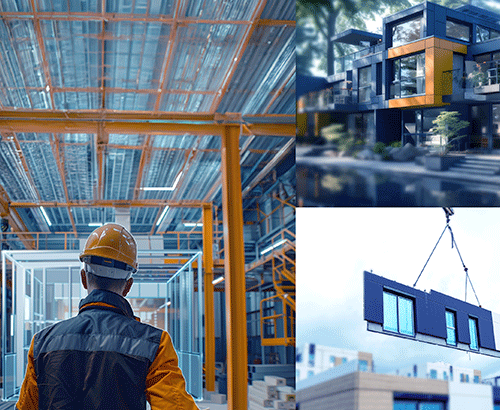Technology and Operational Excellence: Catalyst or Obstacle?

How to select a technology solution that aligns with your company’s overall direction and optimizes resources and information.
Digital technologies are rapidly transforming the way industries conduct business. The engineering and construction (E&C) industry is no exception. To keep pace, many E&C firms are focusing on developing strength in adaptability—that is, the ability to react quickly to opportunities or threats and implement changes effectively across the firm. In today’s world, lack of this ability can be fatal for any good company.
In this article, we discuss how technology is driving “adaptive operations” and provide recommendations on how E&C firms can effectively align and integrate today’s technology with processes, people and business intelligence.
It Starts at the Top
Company leaders must provide customers a clear and unique value and build capabilities to deliver that value consistently. Technology is an important tool that can assist in the delivery of such value. Therefore, leaders must strategically assess how technology will benefit the company’s operations and projects.
A clear value proposition drives an internal sense of urgency or cause for change and the ability to generate buy-in and clarity for the future vision. A shared purpose and awareness are essential to driving change across the company, producing a more flexible and adaptive organization. Integrating technology across an organization is often done more effectively using small teams of peers piloting and leading “local” change.
Companies that are clear on their value propositions and that have secured buy-in can embrace the right technologies and implement them effectively. When a company applies technology appropriately to its operations, it can enjoy a competitive advantage.
“Wherever the new technologies have properly permeated this fragmented industry, the outlook is an almost 20% reduction in total life cycle costs of a project, as well as substantial improvements in completion time, quality and safety.”1
How Today’s Technologies Are Driving Adaptive Operations
There are three digital capabilities that are greatly impacting operations. These alone are impactful capabilities. Combined with operations, they become “multipliers” of capabilities.
Data Capture and Analysis
As an industry, we generate extreme amounts of data; consider the number of estimates, submittals, RFIs, as-builts, invoices, pictures and videos that we produce daily. Costs of storing data are increasingly inexpensive, allowing for effective managing and sharing of information and the opportunity to analyze big data through predictive analytics and performance dashboards, among many other things.
Today an E&C company can place sensors on buildings, equipment, vehicles, parts or other valuable components. These sensors track and report numerous variables, including, but not limited to, location, capacity, temperature, pressure, fuel levels and overall usage. Data collected from the readings can be used for tracking assets, predicting maintenance on equipment, planning projects, generating safety analytics, making schedule decisions and improving work flow and efficiencies.
Just how companies capture and analyze their data determines which strategic and operational advantages they have over their competition. Done well, companies focus on what matters and use data to improve their businesses—from accurate cost pricing to predictive business analytics.
Information Sharing
Never has it been as easy to transmit “almost real-time” information across a company, thus empowering the “edge” of the company with the accurate and timely information to make good decisions. Gathering information back from the field can be transmitted as easily and have incredible impacts across the company.
There are many digital technologies and tools that assist E&C firms with information sharing, including tablets, smartphones, BIM, VR, AR, cloud-based project management systems and client relationship management (CRM) software, to name a few. For example, BIM has been one of the most impactful information sharing solutions to hit the E&C industry. With BIM, multiple parties can interact with the same digital model of a project throughout the project life cycle.
According to the World Economic Forum, “By providing a lifelong view of construction projects, including the TCO, it offers owners great benefits in the commissioning and operations phase, and enables new business models, particularly in asset management. Such a life cycle BIM eventually produces a continuous buildup of know-how by enabling a seamless flow of information across different construction phases and stakeholders.”2
Advances in information sharing technology have helped companies transmit knowledge across operations and put relevant information into the hands of those who need it most. Leadership teams that orchestrate effective information flow will see operational advantages—quicker decision-making, earlier identification of risks, increased employee engagement, etc. And, as a result, the organization is no longer forced to rely on a fixed and static hierarchy of information flow and access.
Value Provision
Gathering, transmitting and analyzing data across projects allow firms to explore nontraditional business areas, including the overall supply chain, operations and maintenance, and a combination of assemblies. We are seeing new technologies impact the integration across project teams, enabling seamless information flow and even creating real-time awareness of materials in use across multiple project sites.
These changes are most evident with offsite construction and modular components and systems. As these delivery methods continue to gain momentum, owners are benefitting from reduced project risk, and E&C firms are recognizing increased productivity. In a 2017 FMI study, “Prefabrication: The Changing Face of Engineering and Construction,” study participants reported that the need for productivity was a key factor influencing the demand for prefabrication (Exhibit 1). Companies that can implement offsite construction and modular components will be positioned to leverage the opportunity and capture more market share across the value chain.
Exhibit 1. Key drivers influencing the demand for prefabricationSource: 2017 FMI/BIMForum Prefabrication Survey
The costs involved in these capabilities are not significant, allowing any size firm the ability to embrace and gain (or enhance) capabilities to better serve its customers. In some cases, smaller firms that employ the concepts and integrate them into their operations program may see disproportionate gains among their competition.
How to Get Started
Before investing in technology to improve operations, firms should ask themselves the following questions:
- How will the technology add value for our customers? Our company?
- How will the technology impact our existing systems and structures? (people, culture, skills, resources, policies, etc.)
- Does the technology have to integrate with existing systems?
- How will we get our team to embrace technology? What time investment and resources will be required?
When considering technology solutions that drive operational capabilities, we also recommend making the decision in the context of “FMI’s Operational Excellence” model. Over the years we have worked with hundreds of clients to improve their operations. Through this work, we have found that there are three primary elements of operations that a company should be focused on: direction, engagement and optimization. When all three of these elements are functioning effectively, companies can achieve true operational excellence (Exhibit 2).
Exhibit 2. FMI’s Operational Excellence Model
If a firm chooses a technology solution that aligns with its overall direction and optimizes resources and information—and if it engages its staff throughout the implementation of the solution—then technology can be used as a catalyst for operational excellence.
Embracing Change
As the E&C industry continues to evolve, companies must aggressively embrace change and adapt. We know that digital technologies have the potential to positively impact most, if not all, operational performance objectives for many E&C firms (e.g., cost, schedule, quality, speed, etc.). Firms can boost that potential by implementing technologies that are in concert with the three elements of operational excellence: direction, engagement and optimization. In the end, technology can serve as a critical catalyst that helps a company adjust and adapt to the evolving built environment.
1 “What’s The Future of the Construction Industry?” World Economic Forum. April 2016.
2 Shaping the Future of Construction: A Breakthrough in Mindset and Technology. May 2016.


.jpg)
